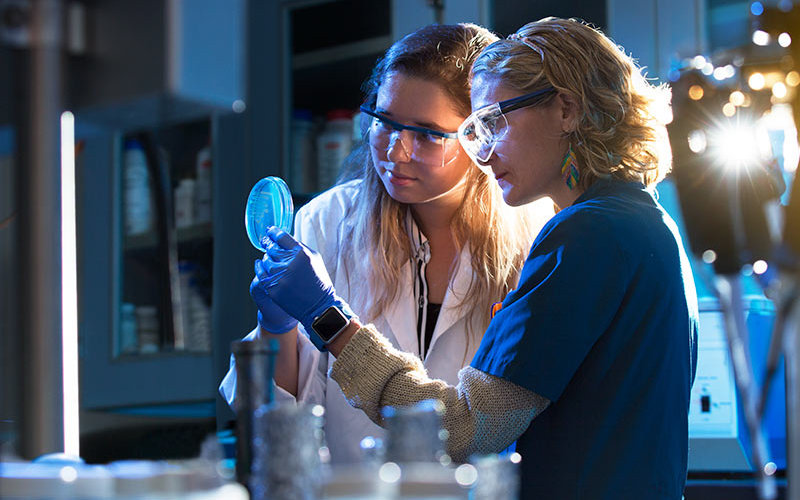
In a lab deep in the bowels of Dan Black Hall, Brettni Quinn is eyedropper-deep in a petri dish of Acinetobacter baumannii, which has been classified by the Centers for Disease Control and Prevention as a serious threat. This little gem of a bacteria has developed resistance to almost all antibiotics.
“The strains of A. baumannii that I work with typically cause hospital-acquired infections,” explains Quinn, left, who is pursuing a master of science in biology.
“I am looking at human products — types of collagen, human serum, mucin and others — to see if they increase transformation rates in A. baumannii.”
In February, the World Health Organization published, for the first time, a list of antibiotic-resistant “priority pathogens” — 12 families of bacteria that “pose the greatest threat to human health,” according to the agency. A. baumannii took the top spot under the “critical” or highest category in a group of bacteria that can cause severe, even deadly infections, and that are able to find new ways to resist treatment.
As drug-resistant strains become increasingly common, a growing contingent of antibiotic resistance fighters at Cal State Fullerton is banding together to confront this public-health issue. In fact, Quinn chose Cal State Fullerton for her graduate studies precisely for its storied research in this field, which includes multiple collaborations between researchers María Soledad Ramírez, assistant professor of biological science, and Marcelo Tolmasky, professor of biological science.
“Our lab’s main focus is how bacteria evolve toward multiresistance,” says Ramírez. “And A. baumannii is considered a paradigm of multiresistance.”
Several mechanisms can cause resistance to antibiotics. One of these is bacteria’s uptake of new genetic information from their environment — i.e., the human body. Ramírez and Quinn’s study, done in collaboration with other students and published last year in Antimicrobial Agents and Chemotherapy, suggests that both albumin — the main protein in blood — and calcium help A. baumannii take in new genes, and in doing so, contribute to the increase of its resistance.
Now, explains Ramírez, “we’re looking at which other products present in our bodies would also prompt this, while trying to determine the mechanism that is taking place in order for this to happen.”
In collaboration with different groups, additional studies taking place in Ramírez’s lab involve how bacteria are transferring resistance traits between each other, the role of emergent pathogens as sources of resistance determinants, the effect of blue light in the physiopathology of different pathogens, and the levels of antibacterial effectiveness in essential oils.
Besides continuing opportunities for students in the Department of Biological Science to participate in research and have their work published, a winter session study-abroad program in clinical microbiology allows students to explore issues of pathogenicity, control and epidemiology of infectious diseases, with research experience and lectures at the University of Buenos Aires’ Hospital de Clínicas José de San Martín.
“Increased resistance to antibiotics is a growing concern,” says Ramírez. “We hope that through collaborative research efforts, we can find novel targets to stop the spread of antibiotic resistance and control infectious diseases.”